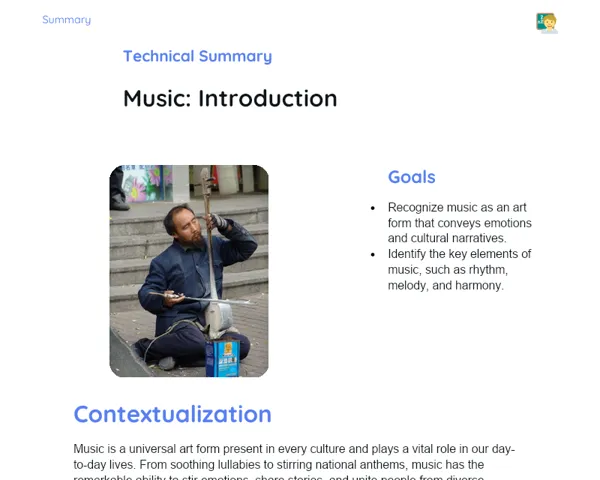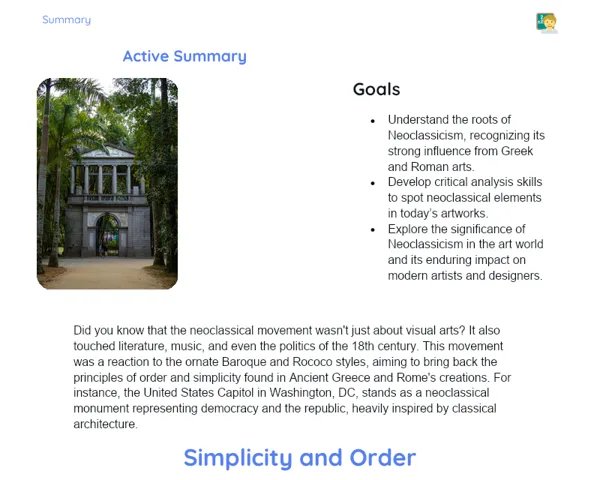Goals
1. Understand the key features of the Romanticism and Realism artistic movements from the 19th century.
2. Identify how these movements continue to influence modern art.
3. Apply concepts of Romanticism and Realism in practical scenarios, like marketing campaigns and creative projects.
Contextualization
Romanticism and Realism, which emerged as significant artistic movements in the 19th century, have greatly impacted contemporary art and culture in India and beyond. Romanticism focused on evoking emotions and personal experiences, often incorporating themes such as nature, love, and the quest for freedom. Realism, on the other hand, aimed for a truthful and unvarnished depiction of reality, highlighting social issues and everyday life. Today, many Indian artists and creators draw inspiration from these movements, using their techniques to address current socio-political topics and emotional nuances. For instance, a designer might harness the emotive qualities of Romanticism in impactful advertising, while a filmmaker could employ Realist techniques to tell genuine, relatable stories.
Subject Relevance
To Remember!
Romanticism
Romanticism was an artistic and literary movement that blossomed in the late 18th and early 19th centuries. It celebrated emotion, imagination, and individual perspective, often standing in contrast to rational thought and classic art forms. Romantic artists delved into themes such as the beauty of nature, the complexities of love, the desire for freedom, and the allure of the exotic, seeking to express profound feelings and unique experiences.
-
Focus on emotion and personal perspective.
-
Key themes include nature, love, freedom, and exotic settings.
-
Rejection of rigid rationalism and classic ideals.
-
Valuation of imagination and personal expression.
-
Lasting impact on modern literature, music, and visual arts.
Realism
Realism emerged as a counter to Romanticism, stressing a candid and accurate depiction of reality. This movement, which developed in the latter half of the 19th century, engaged with social themes and day-to-day life, aiming to showcase life authentically. Realist artists focused on political, economic, and social matters, using straightforward and descriptive language to portray the realities faced by ordinary individuals.
-
Focus on truthful and objective representation.
-
Recurring themes include societal, political, and economic concerns.
-
Depiction of everyday life and the struggles of common people.
-
Rejection of the idealized views promoted by Romanticism.
-
Significant impact on modern literature, theatre, and visual arts.
Influences on Contemporary Art
The legacies of Romanticism and Realism continue to shape contemporary artistic expressions. Modern artists often weave the techniques and themes from these historical movements into their work, addressing pressing social, emotional, and political matters. The emotive qualities of Romanticism can be felt in pieces that stir deep feelings, while the objectivity of Realism is harnessed to portray societal narratives and truthful representations.
-
Continuity and adaptation of Romantic and Realistic techniques.
-
Utilizing Romantic emotional depth to create impactful responses.
-
Employing Realism's truthfulness to highlight contemporary societal issues.
-
Merging both movements to form works that balance emotion and factual storytelling.
-
Crucial in crafting engaging and authentic narratives across art forms.
Practical Applications
-
Graphic Design: Harnessing Romantic aesthetics to design compelling advertising that forges emotional bonds with viewers.
-
Film: Utilizing Realistic techniques to weave authentic narratives that showcase social and everyday realities.
-
Literature: Crafting literary works that interlace Romantic and Realistic elements to deeply explore human experiences.
Key Terms
-
Romanticism: A movement that prioritizes emotion, personal view, and imagination.
-
Realism: A movement that focuses on accurate and truthful representation of reality.
-
Nature: A recurring motif in Romanticism, embodying beauty, power, and enigma.
-
Subjectivity: Focusing on the artist's individual and emotional perspective.
-
Objectivity: Striving to provide a truthful representation of reality.
Questions for Reflections
-
How can the emotional intensity of Romanticism be harnessed to craft engaging narratives in contemporary projects?
-
In what ways can the objectivity and truthfulness of Realism help tackle social issues in modern artworks?
-
How might elements from both Romanticism and Realism be blended to create a piece that is equally emotionally resonant and socially relevant?
Creating a Visual Narrative: Merging Romanticism and Realism
For this mini-challenge, your task is to create a visual narrative that fuses elements of both Romanticism and Realism. Aim to develop a small artistic project that employs the subjectivity and emotional depth of Romanticism alongside the accuracy and realism of Realism.
Instructions
-
Select a theme to explore in your visual narrative—this could be a social issue, a historical event, or a personal experience.
-
Draft a preliminary sketch illustrating how you'd blend Romantic and Realistic elements in your piece, considering how emotion and objectivity can enhance each other.
-
Utilize available art supplies (paper, pencils, markers, paints) to realize your artwork, whether it’s a drawing, painting, or collage.
-
Briefly outline how you integrated the concepts of Romanticism and Realism in your work, detailing your decisions and the message you intend to convey.
-
Present your work to the class and engage in a discussion about the diverse approaches adopted by your peers.



